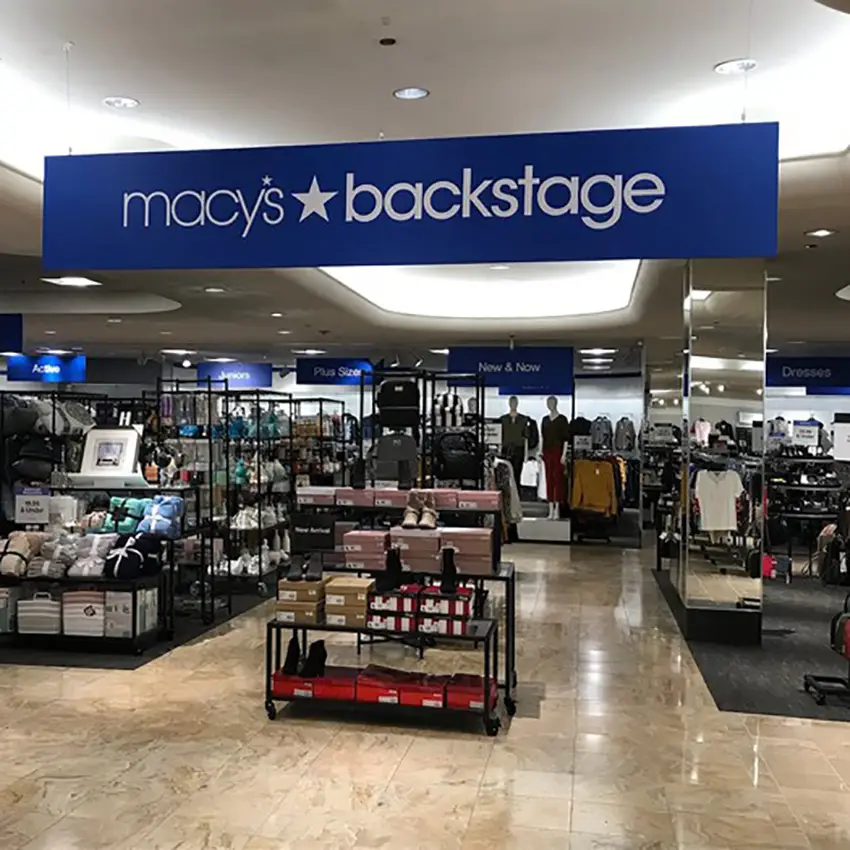In recent weeks, Macy’s has resumed expanding its Backstage off-price chain, following a pause while the department store giant fought through the worst of the Covid-19 pandemic last year.
Since the beginning of April, the company has opened 26 new Backstage stores within full-line Macy’s locations. That brings the Backstage store count to an even 250. Another eight new locations are set to open on May 15, putting Macy’s close to its target of opening 45 new Backstage stores within Macy’s full-line stores in 2021. The retailer also plans to open some freestanding Backstage stores this year for the first time since 2015.
Full-price department stores have been unable to grow over the past five-plus years despite (in some cases) heavy investments in ecommerce, store remodels, and in-store technology. Meanwhile, the top off-price chains have grown rapidly, seemingly with little effort.
This move to double down on Backstage has brought renewed criticism from retail pundits who believe the off-price concept is hurting the Macy’s brand and will be dilutive to the company’s margins. Yet Macy”s has no choice but to aggressively pursue growth opportunities in off-price retail, even if it comes at some cost to Macy’s traditional business. After all, off-price and discount retail concepts will grow at the expense of the rest of the industry for the foreseeable future.
A Controversial Concept
Many retail thought leaders have heaped criticism on the Backstage concept since it was unveiled in 2015. In 2017, Neil Saunders of GlobalData told Reuters that putting Backstage stores inside full-line Macy’s stores was confusing customers about the brand. Ken Perkins of Retail Metrics argued that the off-price sections would cannibalize sales of higher-price items throughout the rest of the store.
Most contributors to a discussion on RetailWire later that year agreed that Macy’s would damage its brand by putting off-price stores within its existing full-line stores. While some thought that Backstage could help the company in the short run, the consensus was that Macy’s off-price strategy would ultimately prove to be a mistake.
Forbes contributor Sanford Stein recently leveled similar criticism at Macy’s after CEO Jeff Gennette revealed that the company plans to accelerate the Backstage concept’s growth. He argues that this growing reliance on off-price retail will hurt Macy’s margins while diluting its brand value.
Instead, Stein advises that Macy’s should move up-market by “improving the customer experience, presentation, visual merchandising, and service” and that it “should leave the discounting to the discounters.”
The False Promise of Full-Price Selling
Stein is hardly the first to observe “that every other department store player that relied too heavily on price cutting has met (or will meet) with demise.” Considering how many department store chains have failed over the past few decades, it’s an obvious point.
Yet more recently, upscale department stores have struggled just as much as their mid-price brethren. Just in the past two years, Barneys New York went out of business and Neiman Marcus filed for bankruptcy. Bloomingdale’s (owned by Macy’s) and Saks Fifth Avenue (owned by Hudson’s Bay) have avoided that fate, but neither chain appears to be especially profitable, considering the subpar financial results of their corporate parents.
Among large upscale department store chains, Nordstrom has had the most success. Yet even Nordstrom has performed poorly in recent years. Its full-price businesses generated just shy of $10 billion of revenue in fiscal 2019 (prior to the Covid-19 pandemic). That was virtually unchanged from five years earlier, despite the company’s expansion into Canada, acquisition of Trunk Club, and aggressive ecommerce investments. Operating profit plunged by more than a third over the same period.
Nordstrom’s results make the calls for Macy’s to move up-market seem wildly unrealistic. (It’s important to acknowledge here that Backstage is not Macy’s first or main foray into discounting. Macy’s is primarily a promotional department store that sells most items at substantial discounts from list price.)
The Macy’s brand generated nearly $22 billion in sales in fiscal 2019. No matter how much it might invest in the customer experience and service, Macy’s is unlikely to outdo Nordstrom on those points. Thus, it’s hard to imagine Macy’s managing even $10 billion of annual sales in the long run as a full-price retailer.
Indeed, given that the Macy’s brand produced sales roughly equal to Nordstrom, Saks, Neiman Marcus, and Bloomingdale’s combined in 2019, the ceiling would probably be a good deal lower. Unless the overall pie grows significantly for upscale, full-price department stores (and there’s no reason to believe that would or could happen), a Macy’s that swore off discounting would have to shrink dramatically to match the modest size of its target market.
Off-Price Is Growing Like a Weed
Full-price department stores have been unable to grow over the past five-plus years despite (in some cases) heavy investments in ecommerce, store remodels, and in-store technology. Meanwhile, the top off-price chains have grown rapidly, seemingly with little effort.
Off-price leader TJX Companies generated $32 billion of revenue in the U.S. in its last fiscal year before the pandemic: up 45 percent (roughly $10 billion) from five years earlier. During the same five-year period, Ross Stores also grew its revenue by 45 percent (from $11 billion to $16 billion) and Burlington grew its top line 50 percent, from $4.8 billion to $7.3 billion.
The pandemic disrupted the off-price industry’s growth, but only briefly. Unsurprisingly, traffic to off-price chains recovered much faster than traffic to department stores. As a result, the top off-price retailers are resuming their expansion plans in 2021 and see abundant room for future growth.
Notably, off-price retailers haven’t needed ecommerce to achieve this remarkable growth. TJX has a very small ecommerce business, Ross Stores has never bothered, and Burlington’s new CEO (a Ross Stores veteran) shuttered the company’s ecommerce channel in early 2020.
Just as impressively, TJX and Ross Stores routinely post double-digit operating margins. Prior to the pandemic, Burlington was close to reaching that milestone as well. No department store has come close to that level in more than five years. Rather, department store management teams now view high-single-digit operating margins as an aspirational goal.
Lessons from Successful Department Store Owners
If Macy’s wants to succeed going forward, it ought to follow the examples set by the most successful department store owners of the past quarter-century. So which department store companies have performed well for their shareholders over the long term?
Nordstrom has done decently, considering how many of its peers have gone bankrupt since the mid-1990s. If you invested $10,000 in Nordstrom 25 years ago and reinvested your dividends, you’d now have a little over $50,000. Still, this works out to mediocre annualized gains of less than 7 percent. Moreover, most of this appreciation came in the first 10 years.
Kohl’s was a better option, notwithstanding its reliance on endless coupons and discounting. Thanks to its smaller store sizes, off-mall real estate, and rapid expansion during the late 1990s and 2000s, a $10,000 investment in Kohl’s 25 years ago has turned into nearly $100,000 (again assuming you reinvested all dividends).
Interestingly, Kohl’s has been only a slightly better investment than Alexander’s since 1996. Alexander’s main innovation was that instead of selling valuable real estate to prop up a dying department store chain, it went out of business nearly 30 years ago and kept its real estate: most notably a piece of prime Manhattan property that now houses Bloomberg’s headquarters. That has allowed it to turn a $10,000 investment 25 years ago into over $80,000 today.
None of these three companies came close to the performance of the best department store owner of 25 years ago: the Dayton-Hudson Corporation. Dayton-Hudson used profits from its department store chains (and proceeds from their eventual sale in 2004) to build up the discount chain it had created in 1962: Target. Now known as Target Corporation, the retail powerhouse has turned a $10,000 investment 25 years ago into over $400,000 today!
In short, the best strategies for department store owners over the past quarter-century have been getting out of the department store business and embracing discounting: preferably in an off-mall setting. (Even Nordstrom owes a lot of its more limited success in recent years to the growth of Nordstrom Rack.)
Embrace the Future
There’s no guarantee that Backstage will prove profitable in the long run. Execution is the biggest risk. So far, none of the department stores that have entered the off-price game have achieved the success enjoyed by TJX, Ross, and Burlington. Having the bulk of the Backstage fleet in malls (inside full-line Macy’s stores) also looks like a liability, due to the long-term downtrend in mall traffic.
However, off-price retail represents a viable business model with abundant growth prospects, whereas upscale, service-oriented department stores occupy a small and shrinking niche. (It’s also a niche that Macy’s, Inc. can better serve under the Bloomingdale’s banner.) Moreover, best-in-class off-price retailers boast much higher margins than best-in-class department stores.
Could Backstage erode Macy’s standing as a full-price brand over time? Absolutely. But to a large extent, this ship has already sailed: most Macy’s customers are unwilling to pay full price. If Macy’s refuses to risk cannibalizing its traditional business by moving into off-price, TJX, Ross, and Burlington will continue to take market share from Macy’s in many key merchandise categories.
In the near term, opening Backstage outlets within full-line Macy’s stores is the quickest way to gain scale and build awareness of the Backstage concept.
In the long run, Macy’s will probably be forced to close more full-line stores (including the new Backstage outlets inside). That highlights the need to build a fleet of freestanding, off-mall Backstage stores, of which there are just six at present. Off-mall, off-price stores could be Macy’s best opportunity to remain relevant on a large scale for decades to come. They certainly represent a more promising path forward than moving up-market or doing nothing.
Full disclosure: The author owns shares of Macy’s, Kohl’s, and Nordstrom.





